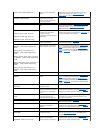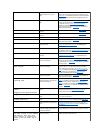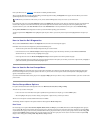
Warning Messages
A warning message alerts you to a possible problem and asks you to take corrective action before the system continues a task. For example, before you format a
diskette, a message may warn you that you may lose all data on the diskette, as a way to protect against inadvertently erasing or writing over the data. These warning
messages usually interrupt the procedure and require you to respond by typing y (yes) or n (no).
Diagnostics Messages
When you run a test group or subtest in the Dell Diagnostics, an error message may result. These particular error messages are not covered in this section. Record the
message on a copy of the Diagnostics Checklist (see "Getting Help"), and then follow the instructions in that section for obtaining technical assistance.
Alert Log Messages From the Dell OpenManage Server Agent
The optional Dell OpenManage Server Agent management application program generates alert messages that appear in the SNMP trap log file. To see the trap log,
select any enterprise under the SNMP trap log icon. Alert log messages consist of information, status, warning, and failure messages for drive, temperature, fan, and
power conditions. More information about the Alert Log window and options is provided in the Dell OpenManage Server Agent documentation found on the Dell
Online Documentation CD.
Back to Contents Page
3-3-2
System configuration check
failure
Replace the system board. See "Getting Help," for instructions on obtaining technical assistance.
3-3-3
Keyboard controller not
detected
Replace the system board. See "Getting Help," for instructions on obtaining technical assistance.
3-3-4
Screen initialization failure
RunthevideotestintheDellDiagnostics.
3-4-2
Screen-retrace test failure
3-4-3
Search for video ROM
failure
4-2-1
No timer tick
Replace the system board. "Getting Help," for instructions on obtaining technical assistance.
4-2-2
Shutdown failure
4-2-3
Gate A20 failure
4-2-4
Unexpected interrupt in
protected mode
Ensure that all expansion cards are properly seated, and then reboot the system.
4-3-1
Improperly seated or faulty
memory modules
Remove and reseat the memory modules. See "Installing Memory Modules" in "Installing System Board Options." If the
problem persists, replace the memory modules. See "Installing Memory Modules" in "Installing System Board Options." If
the problem still persists, see "Getting Help," for instructions on obtaining technical assistance.
4-3-3
Defective system board
Replace the system board. See "Getting Help," for instructions on obtaining technical assistance.
4-3-4
Time-of-day clock stopped
Replace the battery. See "Replacing the System Battery" in "Installing System Board Options." If the problem persists,
replace the system board. See "Getting Help," for instructions on obtaining technical assistance.
4-4-1
Super I/O chip failure
(defective system board)
Replace the system board. See "Getting Help," for instructions on obtaining technical assistance.
4-4-2
Parallel-port test failure
(defective system board)
Replace the system board. See "Getting Help," for instructions on obtaining technical assistance.
4-4-3
Math coprocessor failure
(defective microprocessor)
Remove and reseat the specified microprocessor. See "Adding or Replacing a Microprocessor" in "Installing System Board
Options." If the problem persists, replace the microprocessor. See "Adding or Replacing a Microprocessor" in "Installing
System Board Options." If the problem still persists, see "Getting Help," for instructions on obtaining technical assistance.
4-4-4
Cache test failure (defective
microprocessor)
Remove and reseat the specified microprocessor. See "Adding or Replacing a Microprocessor" in "Installing System Board
Options." If the problem persists, replace the microprocessor. See "Adding or Replacing a Microprocessor" in "Installing
System Board Options." If the problem still persists, see "Getting Help," for instructions on obtaining technical assistance.
NOTE: For the full name of an abbreviation or acronym used in this table, see "Abbreviations and Acronyms."
NOTE: Warning messages are generated by either the application program or the operating system. See "Finding Software Solutions," and the documentation
that accompanied the operating system and application program for more information on warning messages.


















